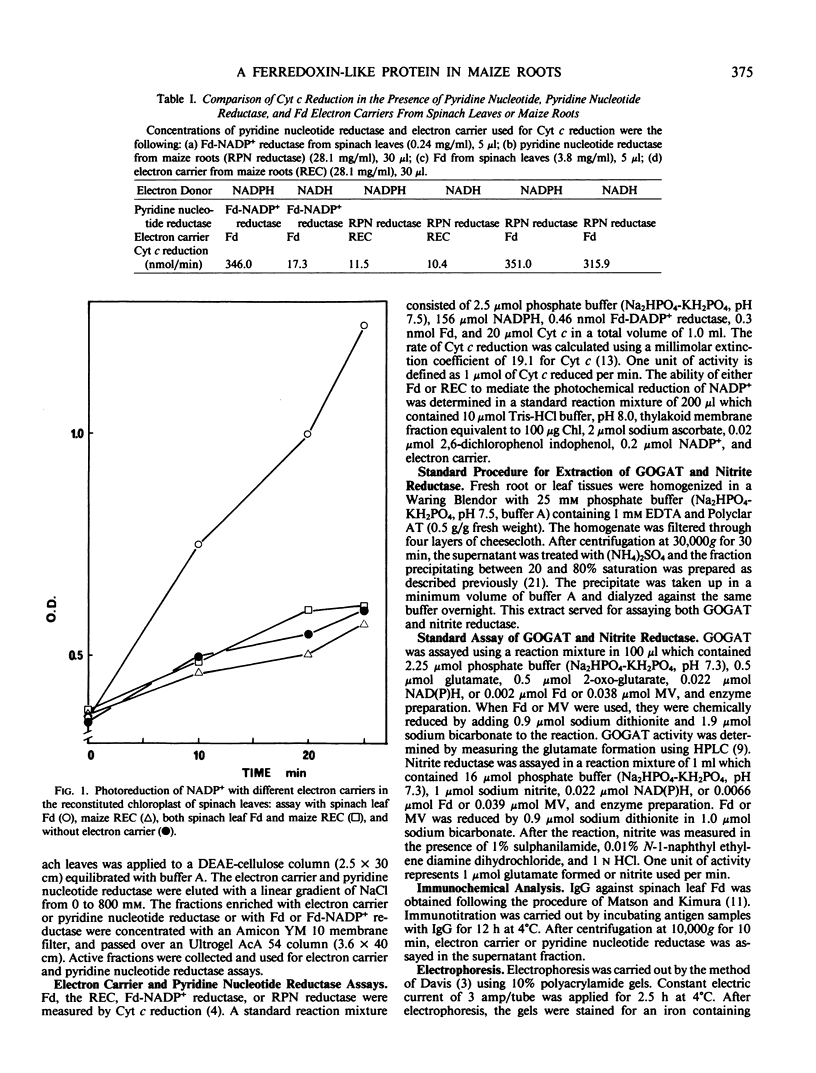Abstract
A non-heme iron containing protein which bears an antigenic similarity to ferredoxin from spinach leaves (Spinacia oleracea L.) has been identified in extracts prepared from young roots of maize (Zea mays L., hybrid W64A × W182E). The ferredoxin-like root electron carrier could substitute for ferredoxin in a cytochrome c reduction system in which pyridine nucleotide (NADPH) reduces the root electron carrier in a reaction catalyzed by ferredoxin-NADP+ reductase (EC 1.6.7.1) from spinach leaves. However, the root electron carrier did not mediate the photoreduction of NADP+ in an illuminated reconstituted chloroplast system.
A pyridine nucleotide reductase which shares identical immunological determinants with the ferredoxin-NADP+ reductase from spinach leaves has also been characterized from maize roots. Root pyridine nucleotide reductase mediated the transfer of electrons from either NADPH or NADH to cytochrome c via ferredoxin or the root electron carrier. Under chemical reducing conditions with sodium dithionite and bicarbonate, the ferredoxin-like root electron carrier served as an electron carrier for the ferredoxin-requiring glutamate synthase (EC 1.4.7.1) and nitrite reductase (EC 1.7.7.1) obtained from maize roots or leaves. In the presence of root pyridine nucleotide reductase and root electron carrier, either NADPH or NADH served as the primary electron donor for glutamate synthesis in extracts from maize roots or leaves. The electron transport system originating with NADH or NADPH, was, however, not able to mediate the reduction of NO2− to NH3.
Full text
PDF




Images in this article
Selected References
These references are in PubMed. This may not be the complete list of references from this article.
- Brill W. J., Westphal J., Stieghorst M., Davis L. C., Shah V. K. Detection of nitrogenase components and other nonheme iron proteins in polyacrylamide gels. Anal Biochem. 1974 Jul;60(1):237–241. doi: 10.1016/0003-2697(74)90149-3. [DOI] [PubMed] [Google Scholar]
- Böhme H. On the role of ferredoxin and ferredoxin-NADP+ reductase in cyclic electron transport of spinach chloroplasts. Eur J Biochem. 1977 Jan;72(2):283–289. doi: 10.1111/j.1432-1033.1977.tb11251.x. [DOI] [PubMed] [Google Scholar]
- DAVIS B. J. DISC ELECTROPHORESIS. II. METHOD AND APPLICATION TO HUMAN SERUM PROTEINS. Ann N Y Acad Sci. 1964 Dec 28;121:404–427. doi: 10.1111/j.1749-6632.1964.tb14213.x. [DOI] [PubMed] [Google Scholar]
- Davis D. J., San Pietro A. Interactions between spinach ferredoxin and other electron carriers. The involvement of a ferredoxin:cytochrome c complex in the ferredoxin-linked cytochrome c reductase activity of ferredoxin:NADP+ oxidoreductase. Arch Biochem Biophys. 1977 Jul;182(1):266–272. doi: 10.1016/0003-9861(77)90307-1. [DOI] [PubMed] [Google Scholar]
- Joy K. W., Hageman R. H. The purification and properties of nitrite reductase from higher plants, and its dependence on ferredoxin. Biochem J. 1966 Jul;100(1):263–273. doi: 10.1042/bj1000263. [DOI] [PMC free article] [PubMed] [Google Scholar]
- Lea P. J., Miflin B. J. Alternative route for nitrogen assimilation in higher plants. Nature. 1974 Oct 18;251(5476):614–616. doi: 10.1038/251614a0. [DOI] [PubMed] [Google Scholar]
- Martin F., Suzuki A., Hirel B. A new high-performance liquid chromatography assay for glutamine synthetase and glutamate synthase in plant tissues. Anal Biochem. 1982 Sep 1;125(1):24–29. doi: 10.1016/0003-2697(82)90378-5. [DOI] [PubMed] [Google Scholar]
- Matson R. S., Kimura T. Immunological quantitation of chloroplast ferredoxin. Biochim Biophys Acta. 1975 Aug 11;396(2):293–300. doi: 10.1016/0005-2728(75)90042-0. [DOI] [PubMed] [Google Scholar]
- Nakamura S., Kimura T. Studies on aggregated multienzyme systems. Stimulation of oxygen uptake of ferredoxin-nicotinamide adenine dinucleotide phosphate reductase-ferredoxin complex by cytochrome. J Biol Chem. 1972 Oct 25;247(20):6462–6468. [PubMed] [Google Scholar]
- SHIN M., ARNON D. I. ENZYMIC MECHANISMS OF PYRIDINE NUCLEOTIDE REDUCTION IN CHLOROPLASTS. J Biol Chem. 1965 Mar;240:1405–1411. [PubMed] [Google Scholar]
- SHIN M., TAGAWA K., ARNON D. I. CRYSTALLIZATION OF FERREDOXIN-TPN REDUCTASE AND ITS ROLE IN THE PHOTOSYNTHETIC APPARATUS OF CHLOROPLASTS. Biochem Z. 1963;338:84–96. [PubMed] [Google Scholar]
- Scopes R. K. Measurement of protein by spectrophotometry at 205 nm. Anal Biochem. 1974 May;59(1):277–282. doi: 10.1016/0003-2697(74)90034-7. [DOI] [PubMed] [Google Scholar]
- Shanmugam K. T., Buchanan B. B., Arnon D. I. Ferredoxins in light- and dark-grown photosynthetic cells with special reference to Rhodospirillum rubrum. Biochim Biophys Acta. 1972 Feb 28;256(2):477–486. doi: 10.1016/0005-2728(72)90076-x. [DOI] [PubMed] [Google Scholar]
- Suzuki A., Vidal J., Gadal P. Glutamate synthase isoforms in rice: immunological studies of enzymes in green leaf, etiolated leaf, and root tissues. Plant Physiol. 1982 Sep;70(3):827–832. doi: 10.1104/pp.70.3.827. [DOI] [PMC free article] [PubMed] [Google Scholar]
- TAGAWA K., ARNON D. I. Ferredoxins as electron carriers in photosynthesis and in the biological production and consumption of hydrogen gas. Nature. 1962 Aug 11;195:537–543. doi: 10.1038/195537a0. [DOI] [PubMed] [Google Scholar]
- Yasunobu K. T., Lovenberg W. The immunological properties of the Clostridium pasteurianum rubredoxin. Arch Biochem Biophys. 1973 Sep;158(1):84–88. doi: 10.1016/0003-9861(73)90599-7. [DOI] [PubMed] [Google Scholar]
- Yoch D. C., Benemann J. R., Valentine R. C., Arnon D. I. The electron transport system in nitrogen fixation by Azotobacter. II. Isolation and function of a new type of ferredoxin. Proc Natl Acad Sci U S A. 1969 Dec;64(4):1404–1410. doi: 10.1073/pnas.64.4.1404. [DOI] [PMC free article] [PubMed] [Google Scholar]



